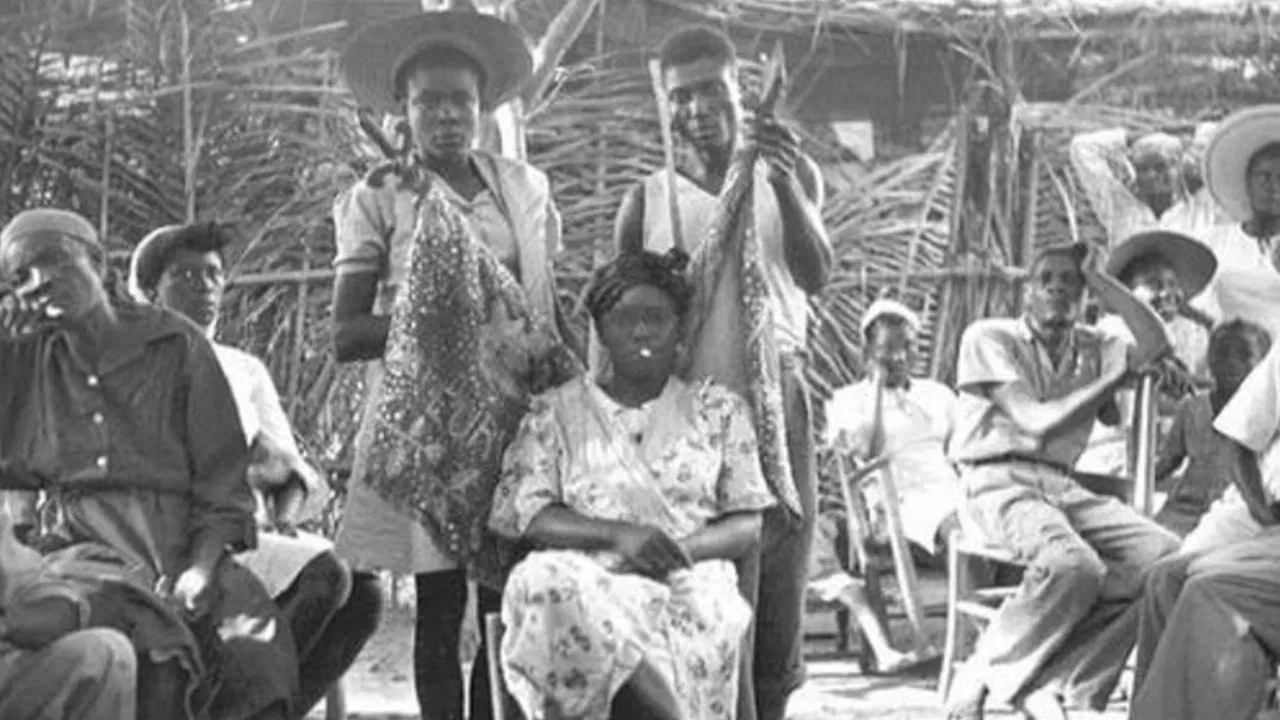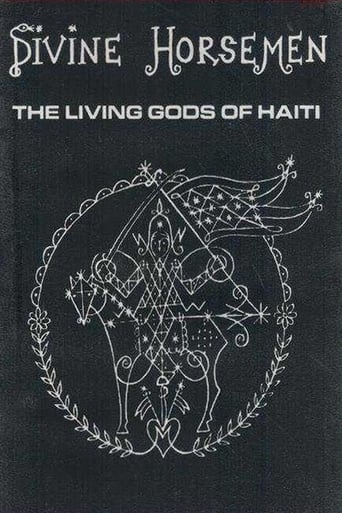

Dreadfully Boring
... View MoreInstead, you get a movie that's enjoyable enough, but leaves you feeling like it could have been much, much more.
... View MoreThis is a must-see and one of the best documentaries - and films - of this year.
... View MoreClose shines in drama with strong language, adult themes.
... View MoreI believe what is fascinating with this work is that the filmmaker maintains both an authentic and insightful depiction of Voudoun whilst incorporating a very specific engagement creating new possibilities and recounting entirely new experiences. Although importantly her study is very informative and is supported by a very detailed book upon the subject, there is much to be said above and beyond pure fact. There is of course a problem identifying Deren's role partaking in the religious ceremonies although she was welcomed by a Voudou priest. It is important to note that she didn't adopt the insulting role of sceptical bystander nor tried to make any allusions to the particular behaviour of various communities partaking in Voudoun, other than those she was able to witness during her time in Haiti. I think this film is extremely eye-opening of the fact that there is much to be said of human behaviour which can only be derived by such phenomenology as is demonstrated by this film.
... View MoreAvant-garde filmmaker Maya Deren is mostly known for short films like Meshes in the Afternoon. A predominant theme of her work is dance. Both literally, and in the 'dance' choreography where the camera manipulates space. Following a win at Cannes, and a Guggenheim Fellowship, she travelled to Tahiti to make a movie about dance. But the dynamics of ritual among Voudoun devotees would throw much light on her academic writings on the artist's responsibility in ethnography.The finished film uses her footage from 1947 to 1951. But it was only released after her death, with explanatory narration from her book of the same name. Observations partake of the dispassionate ethnographer but with an artist's ability to create atmosphere using metaphor. "The rhythm and the sound of the drum brings out the movement of the dancing. It is the drumming which fuses together the 50 or more individuals into a single body, making them move as one. As if all had become linked on the thread of a single pulse." Deren is one of the few Westerners to be admitted to innermost Voudoun rituals. By the end of her stay, she had been accepted as a Mambo priestess. Yet throughout, her scientific candour remains as uncoloured as the studies of JG Fraser.In Voudoun terminology, it is said that the loa (spirit) 'mounts' a person. The symbol is that of the horse and rider. Resulting actions and events are the expression of the will of the rider. Voudoun is syncretic, attempting to reconcile contrary beliefs, often melding practices of various schools of thought. It united disparate tribes of Haiti. It absorbs images from Roman Catholicism.As the supreme God does not interfere with the world, it is to the various loa that devotees pay attention. The film documents several – with associated rituals. Legba is a loa who is the link between the visible mortal world and the invisible immortal realms, the means and avenue between them. He is associated with a crossroads. A junction between worlds through which communication is established. The cross in Voudoun is also a symbol of life and death, of generation and resurrection.One of the more complex ceremonies documented in the film is the celebration of Agwé's wedding. Agwé is the sovereign spirit of the sea, betrothed to the Goddess of Love. He also symbolises the ideal husband - being as the sea is, a ready strength and deep peace.Our Goddess of Love, Erzulie, is mother of man's myth of life. In her, Voudoun salutes woman as love and muse. In a sense, she is the very principle by which man conceives and creates divinity. A beautiful mood accompanies her arrival, an atmosphere of refinement, "as if a fresh cooling breeze has sprung up." The atmosphere becomes less intense.But what about 'possession' – one of the more famous aspects of Voudoun? We see a sudden change come over participants as the loa 'mounts' them. But is it 'real'? Could it be fakery? Hypnotism perhaps? Possessed persons get considerable honour, so the temptation is there. But anthropologists (such as MJ Herskovitz) suggest it is normal in certain cultures. Not put on or induced. A Voudoun priest (a hungon) may also do tests of his own though. For instance, he might get the 'possessed' to drink chilli concentrate to see if they react.I witnessed a Voudoun ceremony on another island - Bali. A young man seeking possession took his turn, dancing excited by drums. He became exceedingly – the easiest word is - 'possessed' – and ran out of the compound into oncoming traffic. He was eventually stopped, but I did not personally doubt his genuineness. He did eventually recover, slightly puzzled.The film shows rituals of life and death at the cemetery. Catholic litanies (action de grace) precede the Voudoun ceremony. As the future springs from the present, life and death are viewed as one.Divine Horsemen doesn't try to avoid 'difficult' aspects. So what of rituals that are more aggressive? Instead of sensationalising, it explains, "If the Rada (tribe of) loa represent the protective, guardian powers, the Petra loa are the patrons of aggressive action. The Petra cult was born out of a cosmic rage. It is the rage against the evil fate which the African suffered because of his enslavement. The energy from that rage enabled him to regain his freedom by winning the revolution against the Napoleonic forces." Such factual accounting extends to sacred animal sacrifice (which some viewers, of course, may find disconcerting).Filming sensitive material presents its own problems. Cameras are intrusive. Deren develops techniques called 'shoot to cut' (which reduces the need for editing) and 'plan to eye,' (which uses a visual shorthand). On the back of her Bolex camera, she taped the commands, Speed Stop Focus Finder Motor. The prompts were there to safeguard shots that could never be redone.A final section of the film shows Tahitian Carnival, Spring Festival. This has some of the most interesting dance sequences, many by talented performers rather than people possessed. Although presided over by a loa, it is not primarily religious. "Carnival celebrates a triumph over death. Of Spring life over the Winter, which was death for the earth. A time for putting the past behind. Of excitement and hope. And promise of a fresh start and a clean beginning." Deren related Voudoun back to her own work and philosophy of art. Using the idea of a collective of people, as found in ritual, she explains how the true artist becomes a channel of creativity, serving those people.Deren has fathomed the deepest recesses of her subject and commits them to film and folio. A faithfulness rarely achieved in either. Her methodology and essays continue to inspire serious artists, filmmakers and researchers. Divine Horsemen: The Living Gods of Haiti, pieced together with primitive film equipment, is a lasting legacy of inestimable value.
... View MoreA sublime and extraordinary documentary on Haitian Voudoun shot during the 50's by Maya Deren. While apparently only planning to bring back rare footage of ritual dance, the artist ended up writing a revealing book on Haitian Voodoun (by the same title) and becoming an actual initiate of the practice. This movie is a must see for anyone even the least bit curious about Voudoun religion or Haitian culture. During the movie you will learn about the various major Gods of the religion, their symbols, and their aspects. Most gripping is the drumming, the dancing, and the authentic footage of human possession taking place. Don't expect much of a plot, however expect footage and drumming that pretty much carries the entire film like a sublime adventure.
... View MoreIf it's Maya Deren you're interested in, and not voudoun itself, then you might want to shuffle this one to the bottom of your list. It's not terrible but it is distinctly reminiscent of those old "film strips" you had to watch in junior high (if you're my age that is).As an educational film 'Divine Horsemen' gives you some good general knowledge about Haitian voudoun beliefs and practices. It's very sincere and respectful, showing an admirable refusal to sensationalize the material. This isn't voodoo from the movies, some of it may have been being "performed" for tourists but it's definitely the real stuff, including actual sacrifices of chickens, a goat, and a bull.Somewhat surprisingly for a Maya Deren film 'Divine Horsemen' suffers from being a little too straight forward. It amounts to fifty minutes of a rather dry narrator talking over grainy black and white footage of various dances and sacrifices to the different loa. The biggest problem with the film is that it's almost all shot in slow motion, in stark contrast to the audio. I'm sure Deren wanted to show the grace of the dancers, which is definitely more apparent when they're at half speed, but forty-five minutes of fast drums and slow dancers wore on my nerves a little. It's so one dimensional that your mind can't help but wander a little, which is aided and abetted by the spectacular, and nearly constant, drumming. Not a good tactic if you're hoping to engage both eye and ear.In the final analysis this film probably will give you a better basic understanding of voudoun than the typical A&E documentary, but it's just a little flat considering it deals with such a vivid subject. Not Maya Deren's most fascinating work by a long shot.
... View More